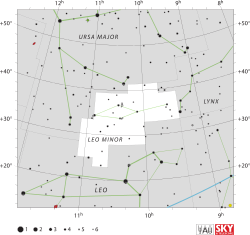20 Leonis Minoris
| 20 Leonis Minoris | |
 | |
| Observationsdata Epok: J2000.0 | |
|---|---|
| Stjärnbild | Lilla lejonet |
| Rektascension | 10t 01m 00,65765s[1] |
| Deklination | +31° 55′ 25,2151″[1] |
| Skenbar magnitud () | +5,40 (V)[2] |
| Stjärntyp | |
| Spektraltyp | G3 Va Hδ1[3] + M7 V[4] |
| U–B | +0,27[5] |
| B–V | +0,64[5] |
| Astrometri | |
| Radialhastighet () | +55,96 ± 0,09[6] km/s |
| Egenrörelse (µ) | RA: -527,63 ± 0,30[1] mas/år Dek.: -429,42 ± 0,18[1] mas/år |
| Parallax () | 66,46 ± 0,32[1] |
| Avstånd | 49,1 ± 0,2 lå (15,05 ± 0,07 pc) |
| Absolut magnitud () | 4,46[7] |
| Detaljer | |
| Massa | 1,12[8] / 0,11[8] M☉ |
| Radie | 1,247 ± 0,021[9] R☉ |
| Luminositet | 1,378 ± 0,027[9] L☉ |
| Temperatur | 5 735 ± 5,6[10] K |
| Ålder | 6,2 - 7,7[11] miljarder år |
| Andra beteckningar | |
| 20 Lmi, LHS 2216, AG+32 990, BD+32 1964, CCDM J10010+3155A, FK5 1258, GJ 376 GJ 376 A, HD 86728, HIC 49081, HIP 49081, HR 3951, IRAS 09581+3209, LSPM J1001+3155, 2MASS J10010072+3155262, NLTT 23166, PLX 2366, PPM 74920, SAO 61808, TD1 14478, TYC 2503-1516-1, USNO-B1.0 1219-00195929, uvby98 100086728, WDS J10010+3155A, WISEA J100100.21+315520.6, Gaia DR2 746545172372256384 [12] | |
20 Leonis Minoris, som är stjärnans Flamsteed-beteckning, är en dubbelstjärna, belägen i den mellersta delen av stjärnbilden Lilla lejonet. Den har en kombinerad skenbar magnitud av ca 5,40[2] och är svagt synlig för blotta ögat där ljusföroreningar ej förekommer. Baserat på parallaxmätning inom Hipparcosuppdraget på ca 66,5[1] mas, beräknas den befinna sig på ett avstånd på ca 49 ljusår (ca 15 parsek) från solen. Den rör sig bort från solen med en heliocentrisk radialhastighet på ca 56 km/s.[5] Den har en relativt stor egenrörelse och hade sin närmaste position till solen för 150 000 år sedan då den befann sig på ett avstånd av 32,2 ljusår,[13]
Egenskaper
Primärstjärnan 20 Leonis Minoris A är en gul till vit stjärna i huvudserien av spektralklass G3 Va Hδ1.[3] Den har en massa som är ca 1,1[8] solmassor, en radie som är ca 1,25[9] solradier och utsänder från dess fotosfär ca 1,4[9] gånger mera energi än solen vid en effektiv temperatur av ca 5 700[10] K.
Den lilla följeslagaren 20 Leonis Minoris A är en aktiv röd stjärna av spektralklass M7 V,[4] som har en relativt hög metallicitet.[14] De två stjärnorna är för närvarande (2019) separerade med 14,5 bågsekunder, vilket motsvarar en projicerad separation av 2 016 AE.[8]
Referenser
- Den här artikeln är helt eller delvis baserad på material från engelskspråkiga Wikipedia, 20 Leonis Minoris, 22 april 2020.
Noter
- ^ [a b c d e f] van Leeuwen, F. (November 2007), "Validation of the new Hipparcos reduction", Astronomy and Astrophysics, 474 (2): 653–664, arXiv:0708.1752, Bibcode:2007A&A...474..653V, doi:10.1051/0004-6361:20078357, hämtad 2009-12-18.
- ^ [a b] Hempelmann, A.; et al. (February 2016), "Measuring rotation periods of solar-like stars using TIGRE. A study of periodic CaII H+K S-index variability", Astronomy & Astrophysics, 586: 19, Bibcode:2016A&A...586A..14H, doi:10.1051/0004-6361/201526972, A14.
- ^ [a b] Keenan, P.; McNeil, R. (October 1989), "The Perkins catalog of revised MK types for the cooler stars", Astrophysical Journal Supplement Series, 71: 245–266, Bibcode:1989ApJS...71..245K, doi:10.1086/191373.
- ^ [a b] West, Andrew A.; et al. (October 2015), "An Activity-Rotation Relationship and Kinematic Analysis of Nearby Mid-to-Late-Type M Dwarfs", The Astrophysical Journal, 812 (1): 12, arXiv:1509.01590, Bibcode:2015ApJ...812....3W, doi:10.1088/0004-637X/812/1/3, 3.
- ^ [a b c] Mermilliod, J.-C. (1986). "Compilation of Eggen's UBV data, transformed to UBV (unpublished)". Catalogue of Eggen's UBV Data. Bibcode:1986EgUBV........0M.
- ^ Gontcharov, G. A. (2006). "Pulkovo Compilation of Radial Velocities for 35 495 Hipparcos stars in a common system". Astronomy Letters. 32 (11): 759–771. arXiv:1606.08053. Bibcode:2006AstL...32..759G. doi:10.1134/S1063773706110065.
- ^ Holmberg, J.; et al. (July 2009), "The Geneva-Copenhagen survey of the solar neighbourhood. III. Improved distances, ages, and kinematics", Astronomy and Astrophysics, 501 (3): 941–947, arXiv:0811.3982, Bibcode:2009A&A...501..941H, doi:10.1051/0004-6361/200811191.
- ^ [a b c d] Tokovinin, A.; Kiyaeva, O. (February 2016), "Eccentricity distribution of wide binaries", Monthly Notices of the Royal Astronomical Society, 456 (2): 2070−2079, arXiv:1512.00278, Bibcode:2016MNRAS.456.2070T, doi:10.1093/mnras/stv2825.
- ^ [a b c d] Boyajian, Tabetha S.; et al. (February 2012), "Stellar Diameters and Temperatures. I. Main-sequence A, F, and G Stars", The Astrophysical Journal, 746 (1): 101, arXiv:1112.3316, Bibcode:2012ApJ...746..101B, doi:10.1088/0004-637X/746/1/101. See Table 10.
- ^ [a b] Kovtyukh; Soubiran, C.; Belik, S. I.; Gorlova, N. I. (2003), "High precision effective temperatures for 181 F-K dwarfs from line-depth ratios", Astronomy and Astrophysics, 411 (3): 559–564, arXiv:astro-ph/0308429, Bibcode:2003A&A...411..559K, doi:10.1051/0004-6361:20031378
- ^ Mamajek, Eric E.; Hillenbrand, Lynne A. (November 2008), "Improved Age Estimation for Solar-Type Dwarfs Using Activity-Rotation Diagnostics", The Astrophysical Journal, 687 (2): 1264–1293, arXiv:0807.1686, Bibcode:2008ApJ...687.1264M, doi:10.1086/591785
- ^ "HD 86728". SIMBAD. Centre de données astronomiques de Strasbourg. Hämtad 2006-07-31.
- ^ Bailer-Jones, C. A. L. (March 2015), "Close encounters of the stellar kind", Astronomy & Astrophysics, 575: 13, arXiv:1412.3648, Bibcode:2015A&A...575A..35B, doi:10.1051/0004-6361/201425221, A35.
- ^ Gizis, J. E.; et al. (2000), "Two Nearby M Dwarf Binaries from 2MASS", Monthly Notices of the Royal Astronomical Society, 311 (2): 385, Bibcode:2000MNRAS.311..385G, doi:10.1046/j.1365-8711.2000.03060.x
Externa länkar
- https://www.universeguide.com/star/20leonisminoris
- * ”4C00774”. ARICNS. Arkiverad från originalet den 7 juni 2011. https://web.archive.org/web/20110607164700/http://www.ari.uni-heidelberg.de/datenbanken/aricns/cnspages/4c00774.htm. Läst 31 juli 2006.
Media som används på denna webbplats
Författare/Upphovsman: IAU and Sky & Telescope magazine (Roger Sinnott & Rick Fienberg), Licens: CC BY 3.0
IAU Leo Minor chart, modified with Flamsteed stars that are part of asterism added.


